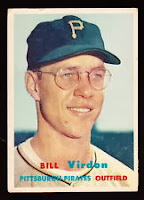Eighty-two. In a 162-game season, a team needs eighty-two victories to ensure a winning record. For two long decades, beginning in 1993, this proved to be too high a number for the hard-luck Pittsburgh Pirates to achieve. Finally, in 2013, the Pirates broke through with 94 wins. A generation of young Bucs fans saw their team head to the post season for the first time. But for more veteran fans, the 2013 season evoked memories of the great Pirates teams of the 60s and 70s. Some of those fans may have even felt inspired to visit the University of Pittsburgh to see what remains of Forbes Field, home of three world-series champion teams - including the 1960 club who beat the heavily-favored Yankees in 7 games.
It was September of 2009 when I stood on these hallowed grounds. More specifically, I stood in what was once the outfield, staring at a segment of the wall - the only part of the stadium still in tact. I tingled as I explored the same space once occupied by Hall-of-Famers Ralph Kiner, Roberto Clemente, and Willie Stargell. I touched the flag pole in center field. I planted my feet in the grass, waited to react to an imaginary pitch, and said to myself - maybe even out loud - "hey... wait a minute... why is there a flag pole in center field?"
I was born too late to ever have seen a game at Forbes, and I had certainly never seen a flag pole in playable territory before. Naturally, I was curious. Was the flag pole part of the stadium's original design? If so, how did the center fielder play around it? Or was it erected by the university at a later date? When I returned home to Washington DC, I inquired among my older relatives and colleagues, but none of them remembered the pole. Not even my 70 year old co-worker Malcolm, who loved to regale the junior staff with tales of baseball's glory days, could recall any such item obstructing outfield play. I conducted an internet search to find more information, but very little was available. I was losing hope that I would ever satisfy my curiosity.
Baseball road trips have a funny way of circling back on themselves. In 2010, I returned to Pittsburgh to
My friend was also able to get us into PNC Park for a pre-game panel discussion that included a couple of team administrators. The panelists answered questions about recent trades, the team's development, and various moments in recent Pirates history. It was interesting. Then something unexpected happened. The moderator announced that several members of the 1960 team were about to enter the room. He introduced them by position as they walked in: Pinch hitter Joe Christopher, utility infielder Dick Schofield, and center fielder Bill Virdon. I quickly replayed the introduction in my head. Did he just say "center fielder"? Yes, I was certain of it.

When the event was over, I made my way through the crowd and approached Mr. Virdon. We made small talk for a bit and then I asked him the question that had been banging around my brain for almost a year: "Bill, how did you play the flag pole in Center Field?" His facial expression perked up as if thinking about the past had the power to restore a small portion of lost youth. Even his voice strengthened a little with nastolgic undertones. Reminiscently, he reminded me that the flagpole was nearly 460 feet from home plate. It hadn't occurred to me that outfields were a lot deeper in his day than in modern ballparks (PNC is 399' to dead center). Few hitters, then or now, have the ability to drive the ball that far on a regular basis. Therefore, the flag pole hardly ever came into play. It was more or less a non-issue.
I thanked Bill for his time and chatted with a few other former players. My friend offered to take some pictures, and for an unknown reason that haunts me to this day, I said "no thanks, that's okay." What was I thinking? But at least I finally had an answer to the mystery of the flag pole.
That's the magic of baseball road trips.


